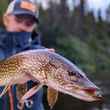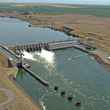Lander Crook tried in vain to free his flies from a tree. I stood upstream 50 yards or so and watched, slightly bemused, while he twisted and pulled his fly rod in directions I don’t think it was ever designed to go. But Lander has been my best friend since we were both five years old, so when it was apparent the flies weren’t coming out of the tree, I waded downstream to offer friendly advice.
“Don’t catch the tree,” I said, grabbing his leader and breaking it off with a snap. “Leader and flies are expensive – especially since I tie all your flies for free.”
“And who drove here this morning?” Lander countered.
I ignored him, too busy focusing on a blood knot so I could get him back into some fish.
The fishing was fast and furious, as it so often is up in the high country. We were wading our way up Rock Creek, which is the largest drainage on the South Slope of Utah’s Uinta Mountains. On that section, between confluences with two slightly smaller, but still fishy tributary streams, Rock Creek is fast, steep, and awfully far away from any road, which is why the fishing was so fantastic.
More Like This
At least, it was fantastic for me.
As kids, the roles were reversed. Lander comes from a family of worm-dunkers. When we got together to go fishing as kids, Lander’s tackle box was full to bursting with Blue Fox and Panther Martin lures, and half-full cans of rainbow garlic Power Bait.
I had flies and an admonition from my dad to not break his fly rod. Unsurprisingly, Lander out-caught me a lot in those days. I tried making graceful, arcing casts but often ended up tangled or in a tree. Lander plunked a baited hook down, sat in a camp chair, and reeled in dinner before I’d made a dozen casts. Eventually, I put the fly rod away and brought my own camp chair. Lander was kind enough to share the rainbow garlic Power Bait.
Then, he made the high school basketball team, and I was cut after the first round of tryouts. I was suddenly without my longtime fishing buddy, and bait fishing alone just didn’t have the same appeal as it did when my best friend was around.
So, I dusted off dad’s old fly rod, and got back to the small creeks and streams that trickled down the canyons of the Rocky Mountains near my childhood home in central Utah. While Lander was at basketball practice, I was on the river, becoming intimately familiar with the wild rainbow trout on our local creek. Lander went to just about every dance in high school – I went to three. Once, as a sophomore, I had a girl ask me to a dance just as I’d finished making plans to go fishing that weekend with my dad.
I didn’t go dancing.
That I ended up more adept at fly fishing than Lander wasn’t a surprise, but it still felt odd to be the one giving him pointers. As I finished tying on another dry-dropper-dropper rig on for him, I pointed to Rock Creek.
“You have too much line out, and this is all pocket water,” I said. “You don’t need to really cast, so much as you need to sort of dangle the line through the holes.”
“What are pockets again?” Lander asked.
I walked to a perfect spot of calm water tucked behind a boulder. On either side of me, Rock Creek rushed by, but I stood behind the rock without feeling the current pulling at my pants.
“The calm pockets of water behind rocks, or on the edges of current seams,” I said, pointing out a seam. “You need like, 10 feet of fly line out, and you just toss it up and in like this.”
I demonstrated with his newly-tied rig, and after a short drift, the size 14 elk hair caddis twitched and bounced. I set the hook and pulled a five-inch brook trout clean out of the water.
“The flies work,” I said, slipping the brookie back into Rock Creek. “But that’s all there is to it.”
I handed Lander his fly rod and climbed over the boulders and exposed roots that pass for a bank on that section of Rock Creek, back to the water I’d been working upstream minutes before. The fishing was really fun. Fast, but not boring; easy, but not in a way that allowed me to get lazy with my casts or drifts. And the small brookies struck so quickly at my flies that I missed more fish than I hooked if I wasn’t paying attention.
As the river turned and put Lander out of direct sight, I turned to watch him fish. He was high-sticking his rig through a pocket, and even from 75 yards away, I saw the smile when he set the hook, and the glint of sunlight shining off a trout’s belly. It wasn’t a cheesy the-padawan-becomes-the-master moment; instead, I felt proud in the way guides do when, despite their best efforts to the contrary, we get clients on fish.
Which, I reckoned, was likely how Lander felt when I passed my commercial driver license exam a few months before we went to Rock Creek. Back before the pandemic ended the world, I was in a training program to drive tour buses in Alaska. Lander had worked for the company for years as a driver and trainer, and once I passed the driving portion of the CDL exam, we started making plans for a summer working, and most importantly fishing, in Alaska.
I found a dry cabin on the banks of the Chena River that was perfect for our needs. Lander booked a halibut charter for mid-July, and I was looking into flights to Kotzebue for early August.
Then we locked down most of the world, tourism ground to a glacial halt, and the job – and life – we’d planned for vanished.
Instead of being on Rock Creek, 9,000 feet above sea level, we should’ve been fishing for grayling on our day off on the Chena River, just north of Fairbanks. On the Chena, you often don’t have to hunt for pocket water. The grayling there literally throw themselves at any well-presented dry fly. Some folks look down on grayling, especially in a place like Alaska where salmon, char, and pike are all readily abundant. But there’s a simplicity in throwing dries to grayling that harkens back to those days we spent in camp chairs, drinking orange soda, and waiting to see our bobbers sink. Lander and I had fished the Chena a few years before, and it was always a plan to go back. With jobs and housing secured, we were set for an entire summer of that easygoing, fun fishing that’s too good to be true.
I sighed, walked around the corner, and saw a large pool up ahead. The South Fork of Rock Creek joins the main stem at that pool, and fishing is always great at a confluence. I picked the right side to fish, leaving the left for Lander when he made his way up there.
I watched the water for a minute, didn’t see any rising fish, and pulled line off my old Hardy Princess. I threw a couple of throwaway casts to get my fly line out through my guides when I heard a splash. I looked for my elk hair caddis and couldn’t find it, so I set the hook.
My line went tight and a grayling jumped, its dorsal fin catching the sun and flecks of water flying off its thick, scaly back. I hooped and hollered like I’d just struck gold.
Lander heard the commotion and came running up the river, and we both stood in awe of the 15-inch grayling I coaxed into my net. That’s a good-size grayling for anywhere, let alone a small river in Utah.

After snapping the requisite pictures, the grayling swam off, and I told Lander to take the next cast. He was much more methodical than me. His first cast landed where he wanted, and something came up to eat his dry fly within moments.
I thought I saw a flash of blue and gray, but I wasn’t sure. And I didn’t say anything until I scooped the fish into my net.
“Another grayling!” I yelled.
Lander’s catch was a near carbon-copy of mine.
The chances of catching two grayling, on two consecutive casts, from Rock Creek on an oppressively hot July day, are astronomically tiny.
Those tiny things, though, turn out to be what matter most.

































Comments
KIRK NICHOLS replied on Permalink
Sadly, the south slope of the Uintas is burning right now, west to east, jumping the roads, jumping the rivers.
Pages